Shopify Email Marketing Face-Off: Klaviyo Takes on Sendlane

Why the Right Email Platform Can Make or Break Your Shopify Revenue
Klaviyo for Shopify vs Sendlane is one of the most critical decisions facing growing online retailers today. Here’s what you need to know:
Quick Decision Guide:
- Klaviyo – Best for data-driven merchants who want advanced segmentation and predictive analytics
- Sendlane – Better for businesses seeking simplicity with unified email, SMS, and reviews
- Budget Impact – Klaviyo uses profile-based pricing; Sendlane uses email-credit system
- Learning Curve – Sendlane wins for ease of use; Klaviyo excels in advanced features
- Shopify Integration – Both offer deep native sync with real-time customer data
If you’re running a mid-sized Shopify store and watching competitors pull ahead while your email marketing feels stuck in neutral, you’re not alone. With 81% of small businesses relying on email marketing as their primary channel, choosing between these two powerhouses could be the difference between stagnant sales and explosive growth.
The stakes are real. One brand achieved 34% of its revenue from email campaigns using Sendlane, while another saw a 27% boost in revenue from combined email and SMS attribution. But here’s the thing – the “best” platform depends entirely on your specific needs, team expertise, and growth stage.
This isn’t another generic comparison that leaves you more confused than when you started. We’re diving deep into the features that actually move the needle for Shopify merchants like you – from abandoned cart recovery to predictive customer lifetime value.
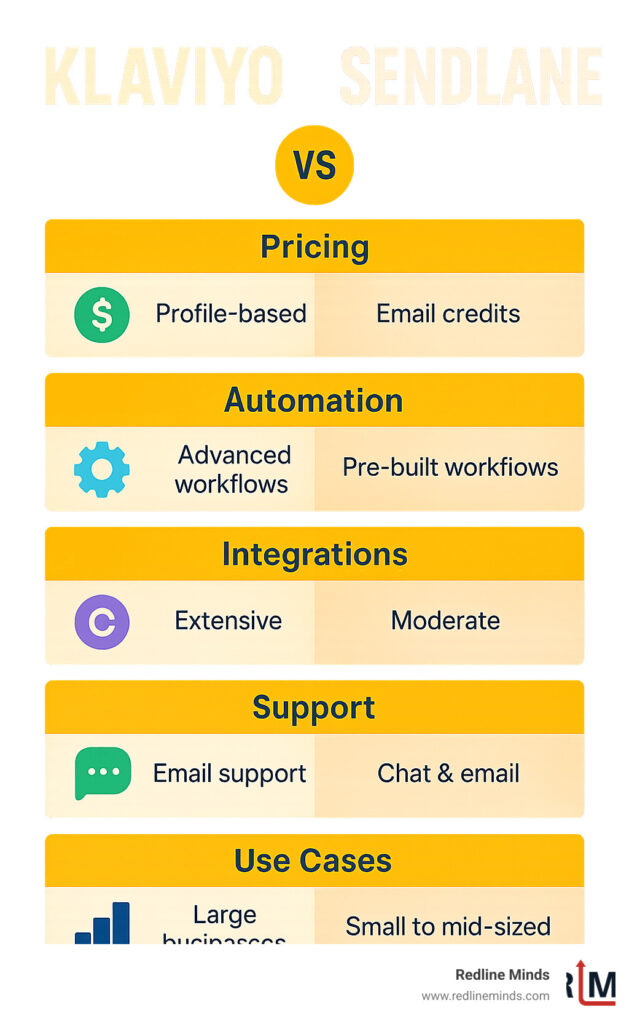
Klaviyo for Shopify vs Sendlane: Quick-Glance Comparison
Let’s cut through the marketing fluff and get to what really matters for your Shopify store. After working with hundreds of ecommerce brands, we’ve seen how the wrong email platform choice can cost you thousands in lost revenue – and the right one can transform your business overnight.
Klaviyo and Sendlane represent two completely different approaches to email marketing. Klaviyo is like having a data scientist on your team – incredibly powerful but requires some technical know-how. Sendlane feels more like your friendly neighborhood marketing assistant – intuitive, helpful, and gets things done without the complexity.
Here’s the reality check: Klaviyo uses a profile-based pricing model where you pay for contacts, while Sendlane operates on an email credit system where you pay per send. Klaviyo offers a genuine free plan for up to 250 contacts, but Sendlane only provides a 14-day trial to test the waters.
When it comes to Shopify integration, both platforms sync beautifully with your store data in real-time. Klaviyo’s native app pulls every customer interaction, while Sendlane’s Guide tracking system gives you deep insights into customer behavior across your entire funnel.
SMS marketing is where things get interesting. Klaviyo supports over 20 countries and treats SMS as a first-class citizen alongside email. Sendlane focuses primarily on the US market with more basic SMS features, but they’re constantly improving.
Klaviyo powers over 157,000 brands with their data-driven approach. They’ve built their reputation on turning raw customer data into hyper-personalized campaigns that feel like one-on-one conversations. Their 60+ automation templates are specifically designed for retail scenarios you’ll actually encounter.
Sendlane takes a unified approach, combining email, SMS, reviews, and forms under one roof. They’ve positioned themselves as the “easy button” for digital marketers who want results without wrestling with complex segmentation rules or steep learning curves.
The automation capabilities tell the real story. Klaviyo offers real-time segmentation with predictive analytics that can forecast customer lifetime value. Sendlane keeps things simpler with manual tagging systems that are easier to understand but less sophisticated.
Customer support is where Sendlane really shines with 24/7 live chat and dedicated account managers. Klaviyo sticks to business hours support through chat and email, which can be frustrating when you’re launching a campaign at midnight.
Why this head-to-head matters for Shopify growth
When merchants ask us about klaviyo for shopify vs sendlane, they’re really asking which platform will help them scale faster without breaking their budget or their sanity. This decision impacts everything from your monthly marketing spend to how quickly your team can adapt to new campaigns.
The revenue impact is staggering. Email marketing generates an average return of $42 for every dollar spent, but only when you’re using the right platform for your specific business model. Choose wrong, and you’ll either overpay for features you’ll never touch or hit growth walls because your platform can’t keep up with your ambitions.
With 81% of small businesses relying on email as their primary customer acquisition channel, this choice literally determines whether you’ll be competing or just surviving in your market.
The scoring criteria we’ll use
We’re evaluating both platforms on four factors that actually matter for your bottom line:
Ease of use determines how quickly your team can start generating revenue instead of fighting with complicated interfaces. Scalability ensures your platform grows with your business instead of holding it back. ROI potential measures the realistic revenue impact you can expect from each platform. Support quality becomes critical when you’re launching a Black Friday campaign and something breaks at the worst possible moment.
These aren’t just nice-to-have features – they’re the difference between email marketing that pays for itself and email marketing that drains your resources.
Deep Dive into Features & Automation
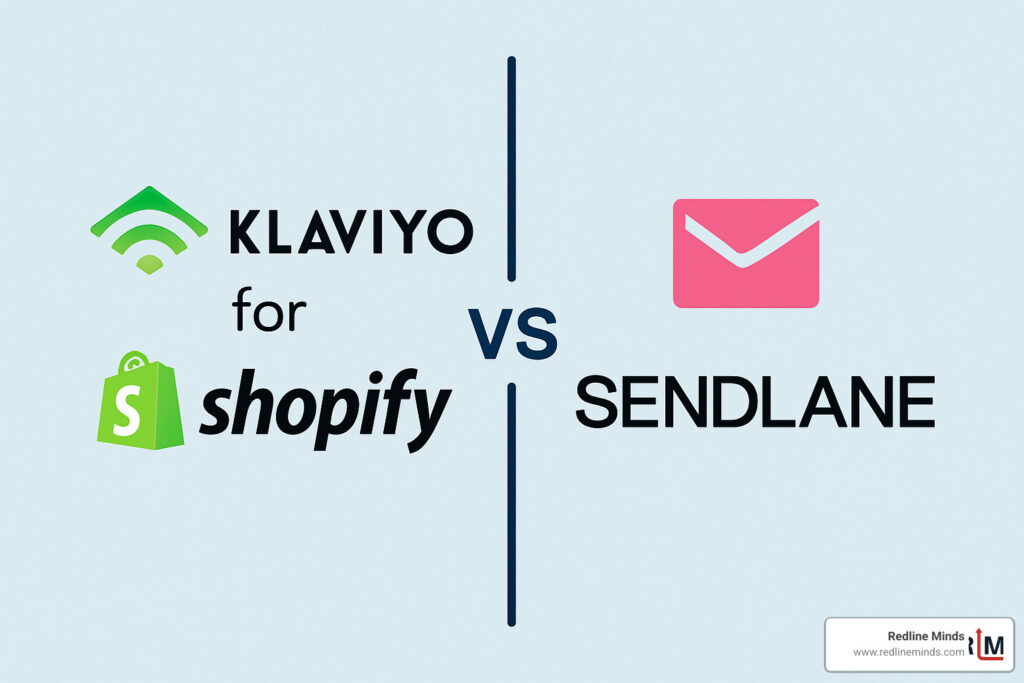
Both tools promise hands-free revenue, but they get there in very different ways.
Klaviyo behaves like an on-staff data scientist. The platform captures every click a shopper makes—even before they opt in—then turns that history into hyper-targeted flows. Sendlane is the quick-start kit. You get an intuitive drag-and-drop builder and a handful of proven templates you can launch the same afternoon you sign up.
Automation Workflows
- Klaviyo: Branching logic, time delays that adjust to each shopper, and AI-driven send-time predictions make it ideal for brands that love tinkering.
- Sendlane: Visual builder plus pre-built flows (welcome, cart recovery, win-back) mean less setup and fewer chances to break something.
Segmentation & Personalization
- Klaviyo’s real-time segments update the instant someone browses or buys, and built-in RFM modeling labels “Champions,” “Loyal,” and “At-Risk” customers automatically.
- Sendlane keeps things manual—tag customers when they hit key milestones, then drop those tags into simple segments. Easier to grasp, but less granular.
Multi-Channel Reach
Klaviyo handles email, SMS, and push in 20+ countries and can generate dynamic Shopify coupons on the fly. Sendlane bundles email, SMS (U.S. only for now), and product reviews under one login so your marketing stack stays lean.
Tracking Technology
- Anonymous visitor tracking (Klaviyo): Shoppers’ product views are stored silently and revealed once they opt in, perfect for ultra-personal product suggestions.
- Guide pixel (Sendlane): Begins tracking after the first email click—simpler and more transparent, though with slightly less historical data.
For merchants who crave even more detail on essential flows, take a look at our must-have email automation guide. If you’re completely new to the channel, a quick read of this primer explains why email remains the highest-ROI digital tactic.
Pricing & ROI: Which Fits Your Shopify Growth Stage?
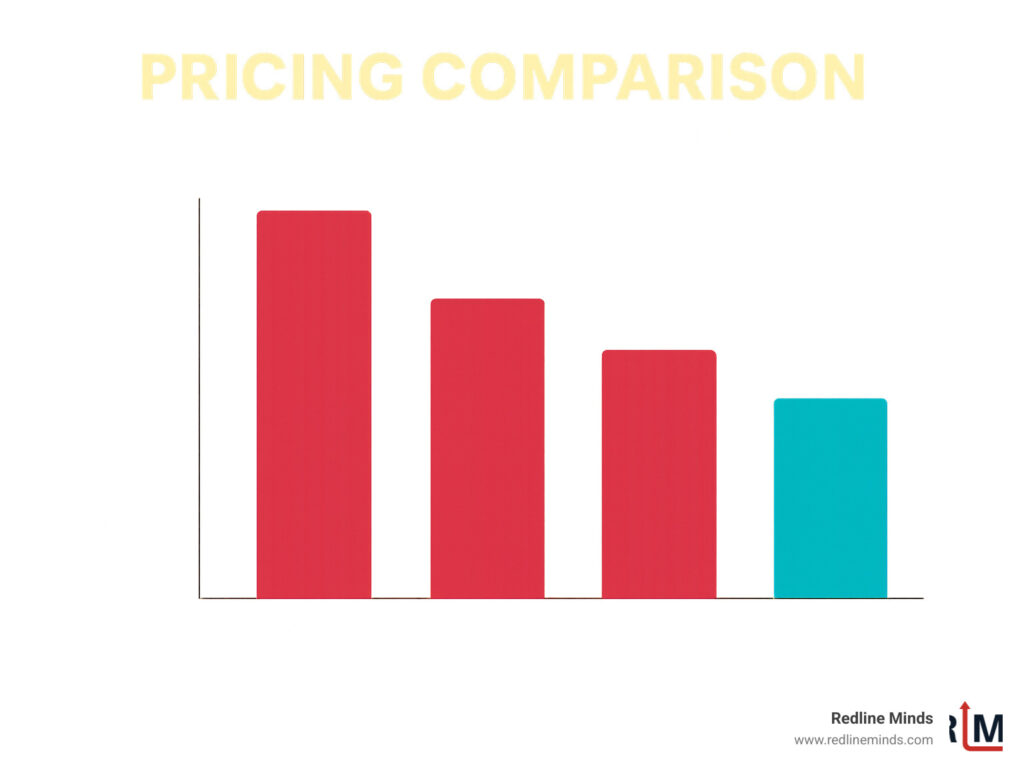
Money matters, but the way each platform charges can work for or against you depending on how you send.
Klaviyo: Profile-Based Billing
- Free up to 250 contacts (500 emails/mo & 150 SMS credits).
- After that, cost scales with every new profile—even if that shopper never opens an email.
- SMS is an add-on, so budget separately if you need texts.
Sendlane: Usage-Based Credits
- Buy a bucket of email sends and use them across unlimited contacts.
- Perfect for stores that blast infrequently or only target VIP segments.
- Seasonal brands like the flexibility—upgrade for Q4, downgrade in January.
Real-World Returns
Merchants routinely report 30%+ of revenue coming from automated email once either tool is fully implemented. The common thread isn’t the software; it’s consistent execution and thoughtful segmentation.
Bottom line: Heavy senders with a fast-expanding list often find Klaviyo’s predictable tiers easier to budget. Brands with massive dormant lists or sharp seasonality usually save with Sendlane’s credit packs.
Ease of Use, Support & Onboarding Experience
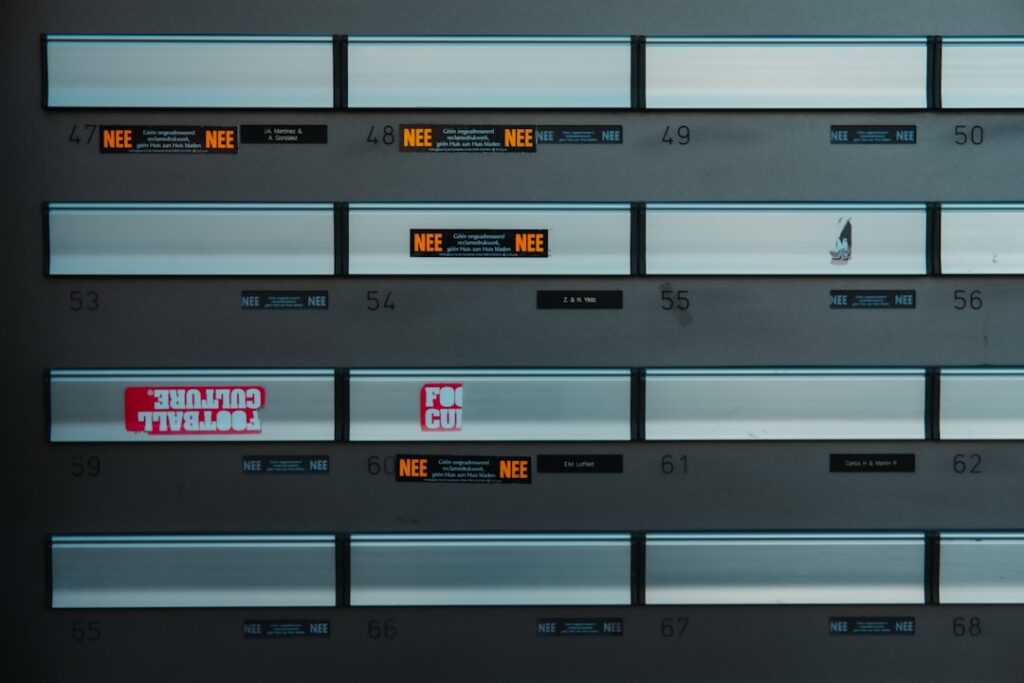
Great features mean nothing if your team can’t find them. Here’s how setup feels on day one:
Onboarding
- Sendlane: A wizard connects Shopify, imports contacts, and launches your first automation in under an hour. 24/7 live chat can even migrate your old ESP for you.
- Klaviyo: Documentation is exhaustive, but you’re largely self-serve. Larger teams appreciate the control; solo founders may feel overwhelmed.
Everyday Workflow
- Sendlane’s dashboard surfaces daily to-do items (e.g., carts to recover) and hides advanced settings until you need them.
- Klaviyo’s interface looks like mission control. Power users love the data density; newcomers may spend extra time clicking around.
Developer Options
Klaviyo’s APIs, webhooks, and universal content blocks let technical teams build endless custom logic. Sendlane offers API access too, but focuses on plug-and-play integrations so non-coders stay productive.
Need a full blueprint for ecommerce email success, regardless of platform? Our email marketing guide walks you through every step—from list growth to deliverability.
Integration Ecosystem & Unique Tools
When you’re running a Shopify store, your email platform doesn’t exist in a vacuum. It needs to play nicely with your review apps, loyalty programs, inventory systems, and everything else that keeps your business humming. This is where the klaviyo for shopify vs sendlane comparison gets really interesting.
Klaviyo takes the “more is more” approach with over 800 integrations available. They want to be the central nervous system for all your customer data, connecting everything from your accounting software to your social media ads. It’s impressive, but it can also feel overwhelming when you’re trying to figure out which integrations actually matter for your business.
Sendlane chose a different path. Instead of trying to connect with everything under the sun, they focused on building rock-solid integrations with the tools that ecommerce businesses actually use every day. Fewer options, but each one is designed to work seamlessly without requiring a technical degree to set up.
Shopify native features & data sync depth
Both platforms offer native Shopify apps, but the depth of what they can do feels completely different. Klaviyo’s real-time data sync means your customer segments update instantly when someone makes a purchase or browses your products. This creates opportunities for incredibly timely emails – like sending a “thanks for your purchase” message with related product recommendations within minutes of checkout.
The speed of this data sync is genuinely impressive. When a customer abandons their cart, Klaviyo knows immediately and can trigger recovery emails based on the exact products left behind, their browsing history, and even predictive analytics about their likelihood to purchase.
Sendlane’s Shopify integration focuses on the essentials with their Guide pixel technology providing detailed customer journey tracking. While it might not capture every single data point like Klaviyo does, it’s often more than sufficient for most Shopify stores – and it’s much easier to understand and use.
The coupon code integration really showcases the difference in philosophy. Klaviyo can generate dynamic Shopify discount codes that automatically apply at checkout, complete with built-in logic for minimum order values and product restrictions. It’s like having a smart assistant that knows exactly which offer to present to each customer.
Sendlane requires third-party tools for bulk coupon generation, which adds a step to the process. However, this approach often provides more flexibility in how codes are distributed and tracked, especially if you’re running complex promotional campaigns across multiple channels.
Third-party extensions & custom builds
Klaviyo’s massive integration library includes connections to loyalty programs, inventory management systems, subscription apps, and social media platforms. This breadth enables some pretty sophisticated automated workflows – imagine automatically sending restock notifications when a customer’s favorite products become available, or triggering loyalty point emails immediately after purchases.
The challenge with having 800+ integrations is figuring out which ones you actually need. It’s like walking into a hardware store with endless aisles – impressive, but potentially overwhelming when you just need to fix a leaky faucet.
Sendlane’s focused integration approach means you’ll find fewer options, but typically better support for each connection. Their integrations with review platforms, SMS providers, and social media tools are designed to work together seamlessly rather than requiring hours of custom configuration to play nicely.
For businesses with technical teams or unique requirements, Klaviyo’s developer-friendly approach shines. Their comprehensive API documentation and webhook flexibility enable custom integrations that go far beyond standard email marketing. You can trigger emails based on custom app events, subscription changes, or complex business logic that’s specific to your store.
Sendlane keeps the technical complexity lower while still offering API access and custom event tracking. Their approach favors pre-built solutions over custom development, which can be either a limitation or a huge time-saver depending on your team’s technical capabilities and available time.
Frequently Asked Questions about klaviyo for shopify vs sendlane
Do both platforms offer free trials?
Klaviyo supplies a perpetual free tier (250 contacts). Sendlane’s “Move Now, Pay Later” program grants full access while you migrate and test—no credit card required.
Which tool is better for small Shopify stores?
If speed and simplicity matter most, Sendlane’s guided setup wins. If you’re already dreaming about advanced segmentation and international SMS, Klaviyo’s free tier lets you start small and scale.
How complex is migrating from another ESP?
Sendlane delivers white-glove migration—its team recreates your automations and verifies everything works before launch. Klaviyo provides detailed import tools and a large knowledge base, ideal for merchants who prefer DIY with granular control.
Regardless of choice, plan a short warming period so inbox providers learn to trust your new sending IPs.
Conclusion
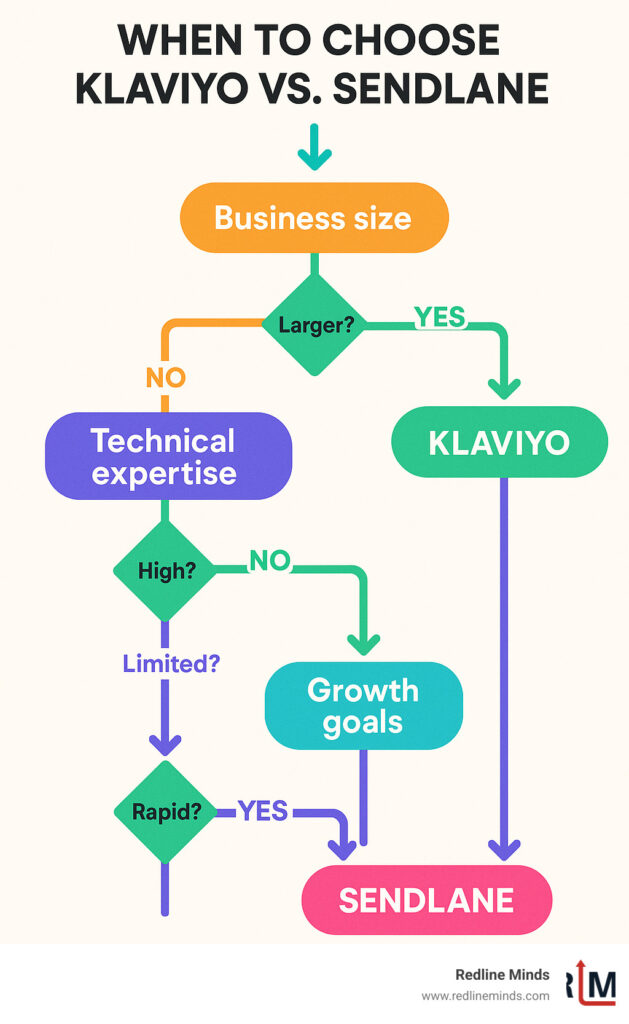
So here we are at the end of our deep dive into klaviyo for shopify vs sendlane, and honestly? Both platforms can absolutely transform your email marketing from a side project into a revenue machine. But choosing the wrong one for your situation is like buying a Ferrari when you need a pickup truck – impressive, but not exactly practical.
Let’s cut through the noise and get real about this decision. If you’re the type of merchant who gets excited about customer lifetime value predictions and wants to segment your audience by browsing behavior patterns, Klaviyo is calling your name. It’s built for data lovers who don’t mind investing time upfront to open up serious personalization power down the road.
But if you’re running a growing Shopify store and just want an email platform that works beautifully without requiring a marketing automation degree, Sendlane makes a lot of sense. Their whole philosophy revolves around getting you results quickly while keeping things simple enough that your entire team can use it effectively.
The budget conversation matters too, but not in the way most people think. It’s not just about monthly costs – it’s about the total investment including your time, training, and the opportunity cost of choosing a platform that doesn’t match your team’s capabilities.
Here’s what we’ve learned from helping dozens of Shopify merchants steer this exact decision: the best platform is always the one that gets used to its full potential. We’ve seen merchants struggle with powerful platforms they never fully implemented, and we’ve seen others thrive with simpler tools they mastered completely.
Think about your team honestly. Do you have someone who loves diving into analytics and building complex automation workflows? Or are you looking for something that your busy store manager can set up and maintain without pulling their hair out?
The integration depth with Shopify is excellent for both platforms, so you’re not making a wrong choice either way. Both sync your customer data in real-time, both handle abandoned cart recovery beautifully, and both can significantly boost your revenue when implemented properly.
The real decision comes down to your growth stage and technical comfort level. Early-stage stores often benefit from Sendlane’s gentler learning curve and hands-on support. Scaling stores with dedicated marketing teams frequently prefer Klaviyo’s advanced segmentation and predictive capabilities.
At the end of the day, the klaviyo for shopify vs sendlane debate isn’t about finding the “perfect” platform – it’s about finding the perfect platform for you. Both companies have built impressive tools that can drive serious results for Shopify merchants.
Our recommendation? Start with whichever platform feels more aligned with your current needs and team capabilities. You can always migrate later as your business evolves, and both platforms offer the tools to make that transition manageable.
Ready to take your email marketing strategy to the next level? Check out our comprehensive resources on online marketing for ecommerce to maximize whatever platform you choose.
The bottom line is this: your email marketing success depends much more on consistent execution than on having the “perfect” platform. Pick the one that excites your team, fits your budget, and matches your technical comfort level. Then commit to using it well, and watch your Shopify revenue grow.


